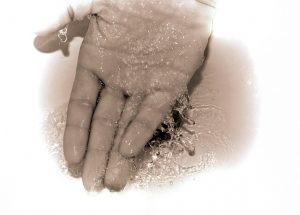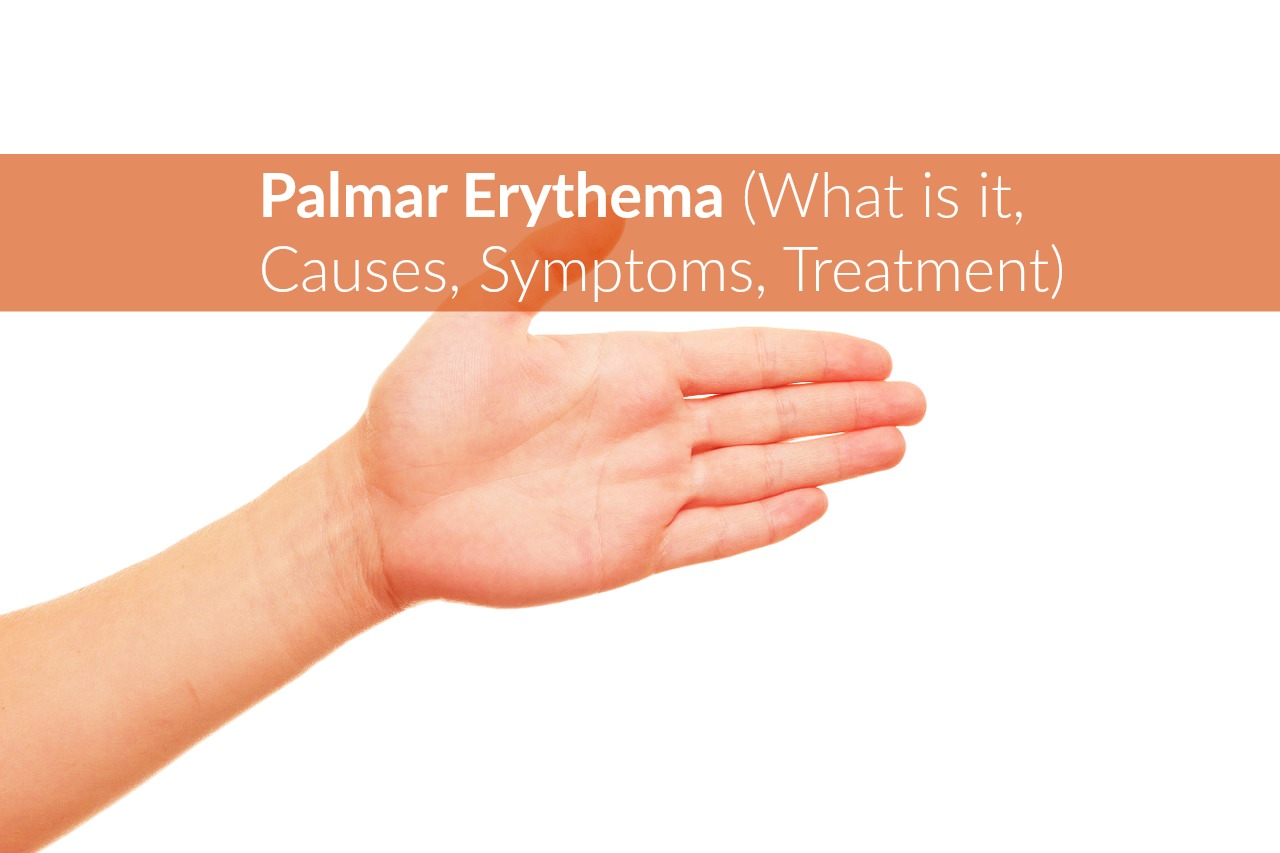Palmar Erythema (also called PE, liver palms or red palms) causes a reddening of the skin on the heel of the palm and often around the edges of the palm and the fingers as well.
While the condition is reported as mostly non-painful and non-itchy, the increased warmth and redness can create its own discomforts.
If you suspect you have this disorder or have already received this diagnosis, this article will give you more information about causes, symptoms, treatment approaches, clinical studies and possible prevention options.
What Causes This Condition?
According to report published in American Journal of Clinical Dermatology, PE is caused when the small capillaries (blood vessels) near the surface of the hands become dilated.(1)
This dilation causes the surrounding skin to take on a reddish cast. Sometimes the affected areas will also feel warmer than the surrounding skin.
How red the skin gets and how much of the hand is affected will depend on factors including heredity and the presence of underlying medical issues.
The areas of the hands that are most commonly affected include:
» The heel of the palm (the part closest to the wrist)
» The outside edges of the palm
» The inside upper palm (just below the start of the fingers)
» The tips of the fingers
In rarer instances, the soles of the feet may also be affected.(2)
Triggers
PE is considered either primary or secondary.(3)
Primary cases are expected cases – for instance, if the individual has a genetic predisposition or others in the family have developed PE.(3)
 Primary Palmar Erythema can arise due to several different factors:
Primary Palmar Erythema can arise due to several different factors:
» Heredity. Here, genetics increase the probability of an individual developing this condition at some point in life.
» Pregnancy. Approximately one-third of expectant mothers will develop Palmar Erythema. Sometimes there is itchiness along with redness when PE arises due to pregnancy.(4) Here, it is the increased estrogen levels in the blood that is thought to trigger the condition.
» Unknown reasons. Also called “idiopathic Palmar Erythema,” in these cases, there is no identifiable reason, including the presence of underlying disease or illness, triggering the case of this health disorder. To date, up to half of all cases of primary PE cannot be linked to any known issue.(5)
Secondary cases of Palmar Erythema arise due to the presence of an underlying medical condition or detrimental lifestyle choice. Common conditions that can trigger secondary Palmar Erythema include:
» Auto-immune diseases. People with rheumatoid arthritis, HIV+ and other auto-immune disorders can develop PE more readily.
» Cancer. Brain cancer and other cancers can trigger a case of Palmar Erythema.
» Congenital syphilis. In cases where the mother passes syphilis to an unborn child, the infant may develop PE.
» Dermatological conditions. Eczema, psoriasis and similar skin conditions can also lead to red palms.(2)
» Lung disease. People with lung obstructions can develop PE.
» Liver disease. More than 20 percent of people with some type of liver disease will also develop Palmar Erythema. In this case, Palmar Erythema is sometimes nicknamed “liver palms.”(6)
» Diabetes, Kawasaki disease & endocrine disruptions. Each makes Palmar Erythema more likely to develop.
» Medications. Certain classes of medications used to treat conditions like epilepsy, bronchitis, emphysema, irregular heartbeat, high cholesterol and liver disease can cause Palmar Erythema as a side effect.(7)
» Hepatitis B & C. Individuals diagnosed with hepatitis often develop Palmar Erythema, according to the Hepatitis B Foundation.(8)
» Exposure to toxins. Exposure to excessive amounts of toxins such as copper (Wilson’s disease) or mercury can cause a reddening of the skin.
» Smoking and drinking alcohol. Smoking regularly and drinking alcohol in excess can induce this disorder.
Symptoms
Palmar Erythema is characterized by a particular suite of symptoms. Symptoms can differ depending on whether it is a case of primary or secondary PE and what conditions may be triggering it to manifest.
Primary symptoms as cataloged by medical doctors and researchers include:(9)
» General redness (can range from dark red to a lighter pink in color)
» Warmth
» Mild swelling
» Itchiness (rare except when related to pregnancy)
» Rash-like redness
» Generally not reported to be painful
Diagnosing
 Achieving a diagnosis of Palmar Erythema begins with taking the patient’s medical history and family medical history. The goal is to identify if there is any possible genetic link to this condition.
Achieving a diagnosis of Palmar Erythema begins with taking the patient’s medical history and family medical history. The goal is to identify if there is any possible genetic link to this condition.
Next, a physical exam will typically be performed to determine the extent of the manifestation and whether it is affecting just the hands or also the soles of the feet.
The physician will also carefully review any present or recent past medications the patient has been taking to see if Palmar Erythema can be a side effect.
From here, the physician may order any or all of the following:(10)
» A CBC (complete blood count) including liver function. This is done to rule out or identify any possible liver issues that could be contributing.
» A specific liver function test. This test measures how well the liver is filtering toxins from the body.
» A blood urea nitrogen/creatinine test. Another measure of liver function and kidney function.(11)
» Tests for Hepatitis B or C. To test for hepatitis.
» Glucose fasting test. To test for diabetes.
» The range of motion tests. To test for rheumatoid arthritis.
» Thyroid stimulating hormone test. To test for underlying endocrine disruptions.
» Chest X-ray. To test for complicating lung and/or heart complications.
The results of these initial tests may indicate further testing to confirm a suspected diagnosis or rule out additional complicating factors.
Treatments
There is no specific treatment for PE itself. Rather, treatments are recommended based on any identified underlying causes.
Successful treatment of underlying causes will result in the dissolution of symptoms. For pregnant women, delivery will typically eliminate all symptoms.
For auto-immune related Palmar Erythema, the use of corticosteroids in short doses can control the symptoms.
If it is discovered that another medication is causing the symptoms of this condition, then treating the Palmar Erythema may require stopping that medication.(12)
This choice must be made depending on what is in the patient’s best health interests.
Clinical Studies
The National Institutes of Health (NIH) have cataloged a growing body of research related to the onset of Palmar Erythema, both primary and secondary.
Here is a partial listing of cataloged studies for further reference:
- PE as an overlooked condition.
- PE and pregnancy.
- PE and pregnancy and liver function.
- PE and drug and alcohol use.
- PE and lupus.
- PE and hoarseness (sarcoidosis).
- PE and HTLV-1.
- PE and neoplasms (tumors).
- PE and arthritis.
- PE and the drug topiramate.
Prevention
 The only known way to prevent this condition is to prevent exposure to or development of any of the primary or secondary reasons for symptoms to arise.
The only known way to prevent this condition is to prevent exposure to or development of any of the primary or secondary reasons for symptoms to arise.
Lifestyle modifications such as ceasing smoking and excess alcohol consumption can greatly reduce the risk. Choosing medications that do not include a reddening of the palms as a potential side effect is another safety measure.
Careful monitoring of overall health can minimize symptoms of Palmar Erythema by providing for early treatment of serious issues such as hepatitis, liver and lung disease, cancer, auto-immune disorders and others as listed here.
Family planning can also be a path to identify whether an unborn child may bear a genetic risk for developing Palmar Erythema. However, since approximately 50 percent of cases of primary Palmar Erythema have no known origin, true prevention is not yet possible.
Conclusion
In summary, while receiving a diagnosis of Palmar Erythema can feel scary and daunting at first, there is much scientific research being done to better understand why cases of this condition arise, what could be causing the symptoms and how to resolve them.
In many ways, the symptoms of PE can be seen as a helpful “early warning system” to assist patients and their physicians with identifying more serious underlying health and medical conditions early on so treatment can begin promptly.
If you are pregnant and have developed reddening of the palms, you can take comfort in knowing that your symptoms will likely dissipate in full after your baby is born. If your case is related to heredity, then your mind may be eased to realize no underlying medical issue is at the root of your symptoms.
If you now suspect you are experiencing symptoms of Palmar Erythema but have not yet confirmed the diagnosis, it is important not to wait!
Taking action right away can pave a way to the early identification of more serious medical issues that require immediate treatment.
References
(1)”link.springer.com/article/10.2165/00128071-200708060-00004
(2)”gpnotebook.co.uk/simplepage.cfm?ID=87359500
(3)”dermnetnz.org/topics/palmar-erythema
(4)”whattoexpect.com/pregnancy/whose-body/skin-red-palms-and-soles.aspx
(5)”gponline.com/red-flag-symptoms-erythema/dermatology/inflammatory-skin-conditions/article/910005
(6)”amjmed.com/article/S0002-9343(09)01015-8/abstract
(7)”sideeffects.embl.de/se/C0014745/pt
(8)”hepb.org/blog/tag/palmar-erythema/
(9)”medicalbite.com/palmar-erythema-pictures-causes-symptoms.html
(10)”healthool.com/palmar-erythema/
(11)”webmd.com/a-to-z-guides/blood-urea-nitrogen#1
(12)”ncbi.nlm.nih.gov/pubmed/18039017
Leave Feedback: Was this article helpful?

